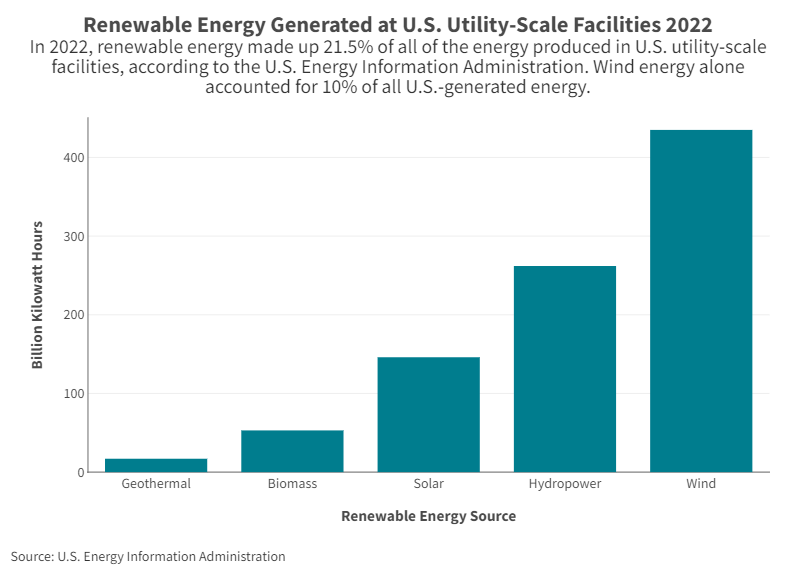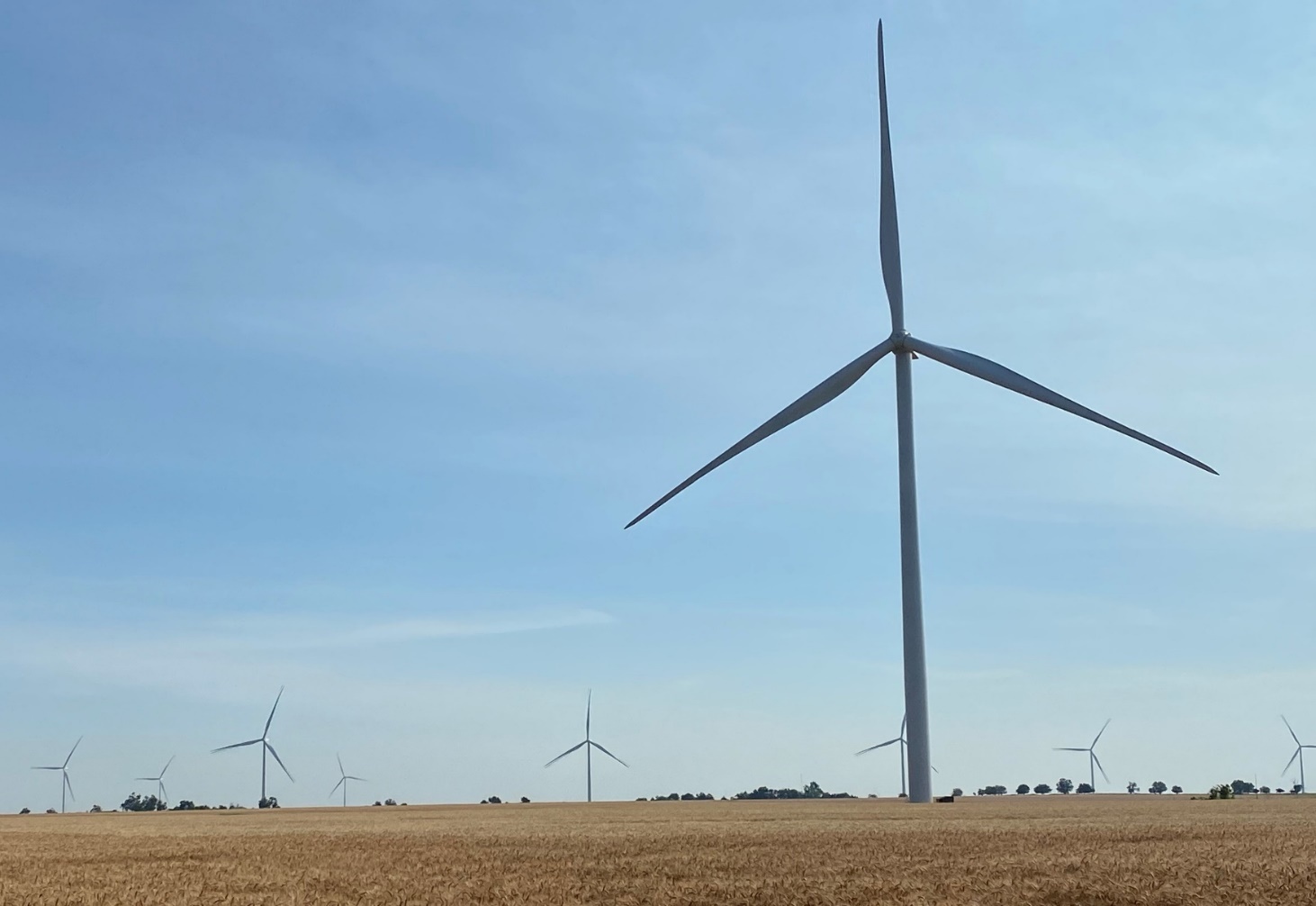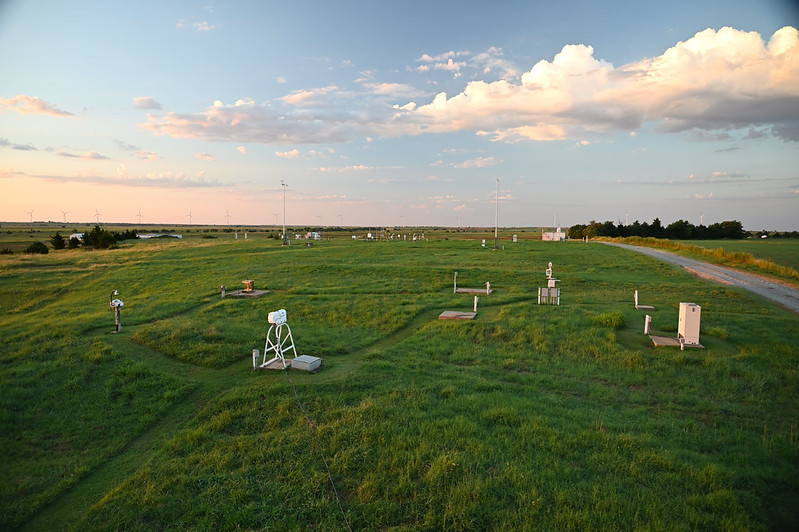AWAKEN: Improving Wind Farms
Published: 21 July 2023
A multi-institutional campaign looks at wind farm wakes to increase clean energy

The United States and other countries must enhance clean energy methods to achieve net zero carbon emissions by 2050. Net zero means that carbon released into the atmosphere is balanced out by removing the same amount from the atmosphere.
Improving current renewable energy sources can boost green energy production. A primary candidate for improvement? Wind energy.
In 2022, wind energy made up over 10% of all electricity produced at utility-scale facilities in the United States, according to the U.S. Energy Information Administration. A utility-scale facility is a power plant that can generate at least 1,000 kilowatts of electricity. Enough wind energy was produced in 2022 to power 40 million U.S. homes.
One way to help increase the energy from wind farms is to study the effects of atmospheric conditions on the efficiency of wind turbines, strategies used to control their operations, and methods to improve their performance.
Enter the American WAKE experimeNt (AWAKEN), supported by the U.S. Department of Energy (DOE).
How Turbines Interact
AWAKEN researchers study how turbines interact with one another and with the atmosphere in ways that degrade their efficiency.
DOE’s Office of Energy Efficiency and Renewable Energy is funding AWAKEN through its Wind Energy Technologies Office. The campaign is scheduled to conclude in 2024.
AWAKEN is a joint campaign between the National Renewable Energy Laboratory (NREL), Sandia National Laboratories, Pacific Northwest National Laboratory (PNNL), and Lawrence Livermore National Laboratory.
Many other entities, including turbine manufacturer General Electric and wind farm owners, are involved as well.
“There is still a lot we don’t understand about how the wind farms interact with the atmosphere,” says Colleen Kaul, a PNNL earth scientist and manager of AWAKEN’s PNNL team.
As the campaign unlocks the physics of these interactions, she adds, “There’s a potential to learn to increase the efficiency of wind farms.”
Scientists and farmers are considering the impacts of wind farms as wind energy becomes more popular.

AWAKEN explores how turbulence—irregular air motion—and turbine wakes can affect turbines’ ability to harvest energy. The campaign also studies how turbulence breaks down turbines, which eventually makes them unusable.
Patrick Moriarty, AWAKEN’s principal investigator and the lead of the Wind Energy Systems group at NREL, says he and a group of international experts drew up their main ideas and science goals for AWAKEN at a meeting in March 2018. They wrote a proposal for DOE later that year and officially started the project in 2019.
The team spent the next few years planning the campaign because of the pandemic and working on contracts with farmers for land access. It deployed the first AWAKEN instruments to Oklahoma in September 2022 and sent the rest in May 2023.
These instruments are gathering data at and near the Southern Great Plains (SGP) atmospheric observatory operated by DOE’s Atmospheric Radiation Measurement (ARM) user facility, which collects continuous atmospheric measurements worldwide. The SGP is in a region that has hosted wind farms for about a decade.
The Perfect Spot

Wind farms operate all over the central United States, but researchers zeroed in on the SGP as the perfect place for AWAKEN. For one, Oklahoma is really flat and windy.
Oklahoma is one of the best places in the United States to use lidars to measure the atmosphere, says Rob Newsom, a PNNL earth scientist who leads an AWAKEN-related lidar campaign at the SGP. The air there is full of particles, so the light from lidars can reflect off more objects in the air and make it easier to measure wind.
In addition, Oklahoma and other Great Plains states experience high turbulence at some points in a day and low turbulence at others. AWAKEN studies both situations at the SGP.
During the day when temperatures are warmer, the air is more turbulent, which breaks down turbine wakes faster and shortens them, says Moriarty. When the air cools at night, the turbulence drops, and the wakes can travel farther.
The 31-year-old SGP is also a good location for AWAKEN because it can support guest instruments alongside instruments that collect long-term data for ARM.
“The ARM site there has been operating for decades,” says Kaul. “There are a lot of climatological data there to compare against.”
Scientists used those data to help plan AWAKEN.
The Wind Within Wind Farms

When a turbine rotates, it forms a wake behind it. This wake takes away momentum and creates turbulence for downstream wind turbines. As a result, the affected turbines cannot generate as much energy.
The same thing happens on a farm-to-farm scale when all the wakes in one farm form a large wake that affects a downstream farm. A single turbine’s wake can be up to 2 kilometers (about 1.2 miles) long, and a wind farm’s wake can go as far as 50 kilometers (31 miles).
Wind farms will be closer together as available space decreases and wind energy becomes more popular.
“These wind farms are going to start interacting with each other more,” says Moriarty.
AWAKEN also looks at how wind variations at different heights affect turbines and wakes. For example, at nighttime at the SGP, the windiest part of the atmosphere is often low to the ground. This low-level “jet” is smooth and fast, so turbines can generate more power. However, it also means the wakes travel longer distances and can affect more downstream turbines.
Lasers Make Measuring Wind Easier

AWAKEN employs a unique measurement strategy involving lidars, which use pulsing light waves to measure wind by reflecting off particles in the atmosphere. This is similar to how radars use pulsing radio waves.
Because light waves are shorter than radio waves, lidar pulses can reflect off smaller objects. This means that lidars can measure cleaner air with smaller particles.
Doppler lidars can measure wind out to about 5 kilometers (3.1 miles). During their AWAKEN-related campaign, Newsom and his team are using Doppler lidar scans to construct a “virtual tower,” which will help them measure the wind speed and direction of turbine wakes. Such a tower eliminates the need for attaching instruments to a physical tower.
It also helps that the lidar system, which is 250 pounds and roughly the size of a dishwasher, can be moved from spot to spot more easily than a physical tower.
To create the virtual tower, two Doppler lidars must work together to do a “cooperative scan,” says Newsom. A single Doppler lidar can only measure air moving toward it or away from it. By itself, this is not enough to measure the wind speed and direction. By adding a second lidar, though, there are two lines of information that intersect. When both lidars scan vertically, this intersection point moves up and down, forming the virtual tower.
Researchers can then calculate a turbine wake’s wind speed and direction from where the scans intersect.

Improving Turbines Reduces Waste

The AWAKEN team also measures precipitation using five different sensors called disdrometers, including one on the top of a turbine, says Kaul. These measurements will help researchers determine how durable wind turbines are—another of AWAKEN’s science missions.
“Even though raindrops seem so small,” says Kaul, “they actually will wear down the turbine blades, cause erosion, and reduce their aerodynamic efficiency,” which is how easily an object can move through the air.
To study such wear, AWAKEN investigates how a turbine’s airflow can affect the impact of raindrops when they land.
AWAKEN researchers also want to know how varying wind speeds affect turbines at different heights. Wind can affect many parts of a turbine, including the gearbox, blades, and shafts.
Turbines are supposed to last at least 20 years, says Kaul, but typically, they are not lasting that long.
“When (engineers) first designed the systems (30 years ago),” says Newsom, “they never really considered realistic atmospheric conditions as inflow into the turbine blades.”
This includes wind variability across the span of turbine blades.
Today, engineers do consider atmospheric conditions when designing turbines. AWAKEN will help researchers and engineers better understand how turbines interact with a variety of atmospheric conditions.
By learning to improve turbines’ durability, energy companies will minimize the number of turbine parts being discarded and replaced.
Data to Optimize Wind Energy

So far, 100 AWAKEN datastreams are available from instruments operated by ARM and other contributors. These data are free for users to download from the PNNL-managed Wind Data Hub. AWAKEN data are also freely available from ARM’s Data Discovery.
Researchers are already analyzing and interpreting the campaign’s data while an AWAKEN modeling team works to validate DOE models about atmosphere-to-farm interactions.
AWAKEN observations will be the focus of posters presented by Moriarty and Newsom on August 9 during the 2023 Joint ARM User Facility/Atmospheric System Research (ASR) Principal Investigators Meeting in Rockville, Maryland.
Collection and analysis of AWAKEN data will inform strategies to make turbines and wind farms more efficient and turbines more durable. The result, researchers hope, is more clean energy.
With a fundamental understanding of how turbines interact with one another in wind farms, “we can design better turbines (and) better control systems,” says Moriarty. “We can better optimize the layout of the wind farms.”
Keep up with the Atmospheric Observer
Updates on ARM news, events, and opportunities delivered to your inbox
ARM User Profile
ARM welcomes users from all institutions and nations. A free ARM user account is needed to access ARM data.


















